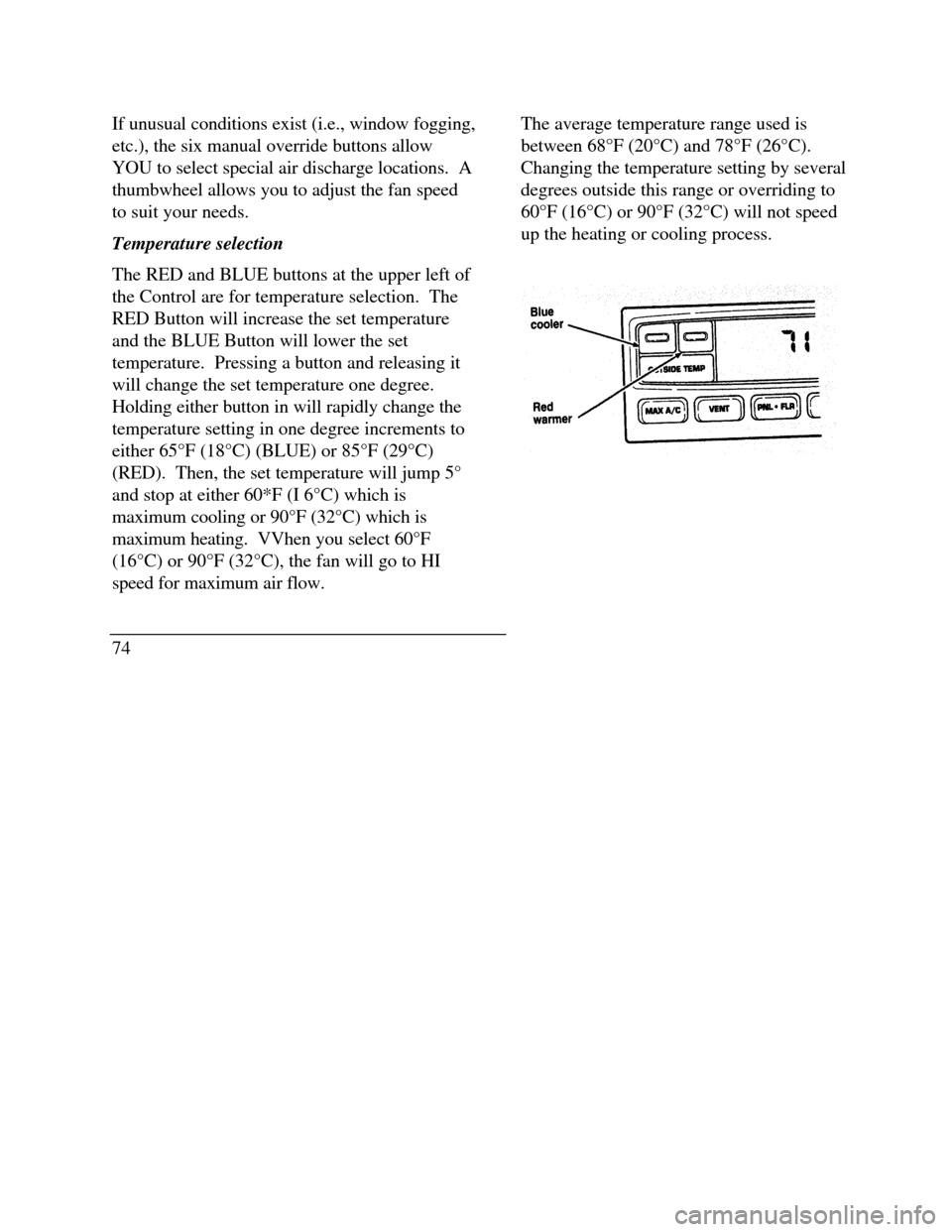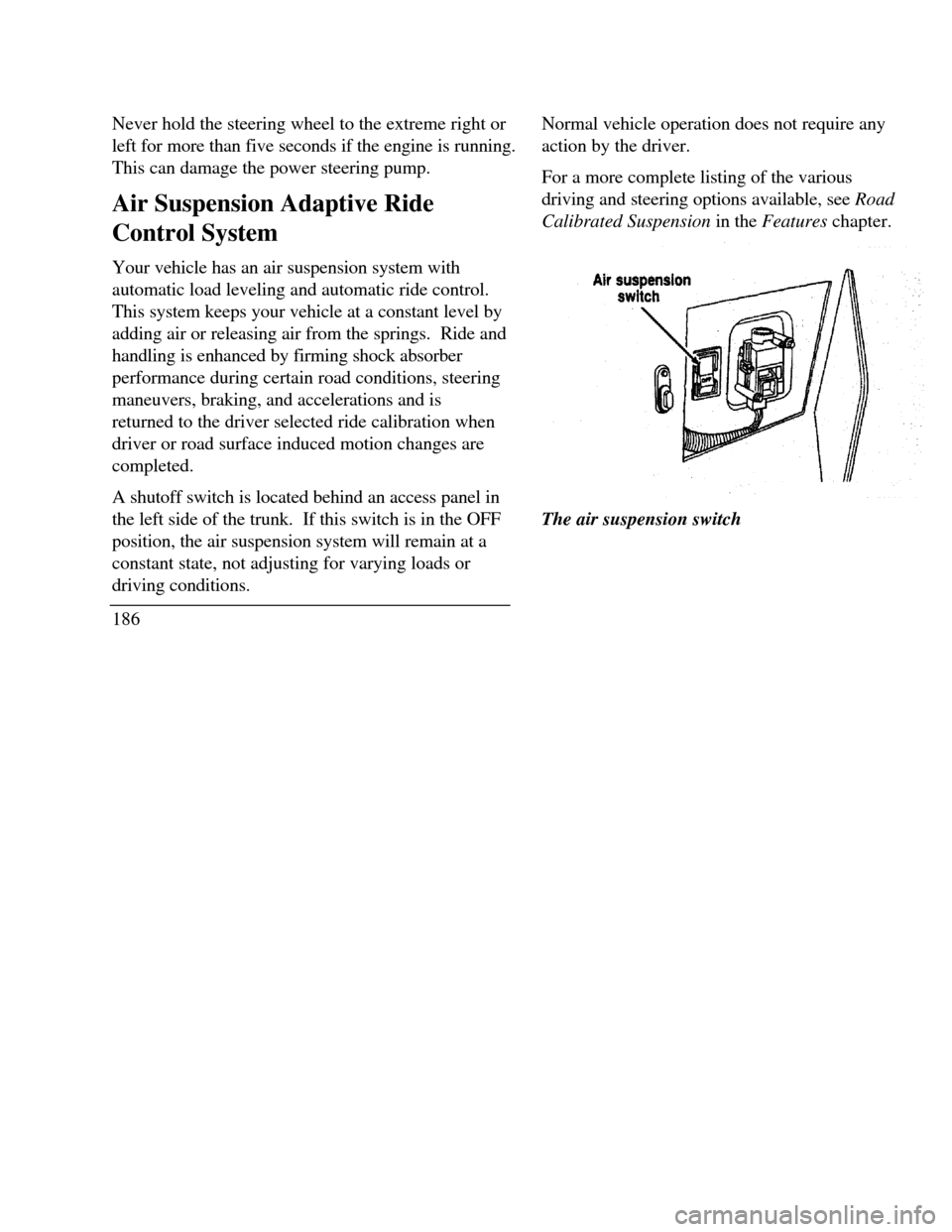1996 LINCOLN CONTINENTAL change wheel
[x] Cancel search: change wheelPage 75 of 320

To turn your EATC on, push the AUTOMATIC
button or any of the six override buttons along
the bottom of the control.
To turn your EATC off, press the OFF button.
When the system is off, the display window will
be blank (dark) except when OUTSIDE TEMP
has been selected. Then, OUTSIDE TEMP and
the temperature will appear in the window.
If you select AUTOMATIC, the system will
automatically determine fan speed and airflow
location. If an override button is selected, your
selection determines airflow location only. Fan
speed remains automatic unless you override it
by rotating the vertical thumbwheel located at
the extreme right of the control panel.
To change the temperature in the display
window, select any temperature between 65°F (I
8°C) and 85°F (29°C) using the BLUE (cooler)
or RED (warmer) buttons. The Electronic
Automatic Temperature Control will do the rest.
72If you want continuous maximum cooling, push the
BLUE button until 60°F (16°C) is shown in the
display window. Your EATC will cool at
maximum and disregard the 60°F (16°C) setting
until you select a warmer temperature with the
RED button. If you want continuous maximum
heating, push the RED button until 90°F (32°C) is
shown in the display window. Your EATC wifl
provide maximum heat regardless of the 90°F
(32°C) setting until you select a cooler temperature
with the BLUE button.
The display window tells you how the system is
operating. It will indicate the selected temperature
and the operating function you have chosen; AUTO
or one of the six manual overrides. It will also
indicate manual (thumbwheel) control of the fan
speed with the symbol. The display window
with all possible displays and their positions are
shown here. Normally not aU are shown at the
same time but are included here to familiarize you
with the names and symbols.
Page 77 of 320

If unusual conditions exist (i.e., window fogging,
etc.), the six manual override buttons allow
YOU to select special air discharge locations. A
thumbwheel allows you to adjust the fan speed
to suit your needs.
Temperature selection
The RED and BLUE buttons at the upper left of
the Control are for temperature selection. The
RED Button will increase the set temperature
and the BLUE Button will lower the set
temperature. Pressing a button and releasing it
will change the set temperature one degree.
Holding either button in will rapidly change the
temperature setting in one degree increments to
either 65°F (18°C) (BLUE) or 85°F (29°C)
(RED). Then, the set temperature will jump 5°
and stop at either 60*F (I 6°C) which is
maximum cooling or 90°F (32°C) which is
maximum heating. VVhen you select 60°F
(16°C) or 90°F (32°C), the fan will go to HI
speed for maximum air flow.
74The average temperature range used is
between 68°F (20°C) and 78°F (26°C).
Changing the temperature setting by several
degrees outside this range or overriding to
60°F (16°C) or 90°F (32°C) will not speed
up the heating or cooling process.
Page 79 of 320

You can override the fan speed at any time. If
you use the thumbwheel to override the fan
speed, the EATC will continue to control the
temperature but you control the fan speed. To
return to auto fan control, press the
AUTOMATIC button. If you are operating in
one of the override functions (FLOOR, MAX
A/C, etc.), automatic fan control will continue
unless you rotate the fan thumbwheel. To
76return to automatic fan control, press the
AUTOMATIC button. The EATC will return
to Automatic operation. If you want to
return to any override function, press the
button for that function. The fan speed will
continue to be automatically controlled.
Manual override buttons
Your EATC has six buttons which allow you
to make special selections. The buttons are
located along the bottom edge of the EATC
control and allow you to determine where the
air will be discharged. Pressing any override
button changes the air discharge location
only. It does not affect the ability of the
system to control temperature or the fan
speed. Return to fully Automatic operation
by pushing the AUTOMATIC button.
Page 81 of 320

FLR & DEF button
Push this button to get air to the floor and
windshield defrosters at the same time. The
display will show the set temperature, FLR and
the Defrost symbol. If the outside temperature
is about 50°F (10°C) and above, the air will be
dehumidified to remove moisture. This will help
to prevent fogging in humid weather.
DEFROST button
Press the Defrost Button to obtain maximum
airflow to the windshield. Adjust the
temperature setting as required for defrosting.
The Display window will show the temperature
setting with the Defrost symbol to the left of the
temperature. When the outside temperature is
about 50°F (10°C) and above, the air will be
dehumidified to remove moisture. This will help
prevent fogging in humid weather.
78OUTSIDE TEMP button
By pressing this button the temperature
of the air outside of the vehicle will show
in the display. The outside temperature
will continue to be displayed until the
OUTSIDE TEMP button is pressed
again to cancel. If the selected
temperature setting is changed while the
outside temperature is displayed, the new
selected temperature will be displayed for
4 seconds after it is changed. Then, the
outside temperature will return to the
window. If a manual override is pressed
or the thumbwheel is rotated while the
outside temperature is displayed, the
window will show the change for 4
seconds. Then, the outside temperature
will return along with the changed
override selection.
Page 98 of 320

To change the position of the steering wheel, pull
the release lever on the column toward you. Tip
the steering wheel to the desired position.
Release the lever to lock the steering wheel in
place.
Speed Control
Your vehicle has speed control, so you can
automatically maintain a constant speed above 30
mph (48 km/h). The switches to operate the
speed control are on the steering wheel.
Use of radio transmitting equipment that is not
Federal Communications Commission (FCC) or
in Canada the Canadian Radio and
Telecommunications Commission (CRTC)
approved may cause the speed control to
malfunction. Therefore, use only properly
installed FCC (CRTC in Canada) approved radio
transmitting equipment in your vehicle.NOTE: Since your vehicle has an Automatic
Overdrive Transaxle, you may want to drive in D
(Drive) when driving in hilly terrain, at higher
altitudes, or when pulling a trailer. This will
improve speed control performance.
NOTE: Do not shift to N (Neutral) when using
the speed control. This will cause the engine to
overspeed.
95
Page 145 of 320

At zero pressure, the Securitires will provide you
with a minimum driving capability of approximately
20 miles (30 kms). How you drive and the actual
amount of air pressure left in your tires will
determine exactly how many miles can be driven.
To extend the mileage and help prevent damage to
low or deflated tires, you should: not exceed 55 mph (90 km/h) and drive at a
reduced rate of speed, if possible avoid excessive hard steering and braking
maneuvers, if possible stop periodically to allow the tires to cool down/! WARNINGIf your vehicle is driven with a low tire, thetire itself may become very hot. Allow thetire and wheel to cool before attempting tochange it.142Pressure Alert System
Each of your Securitires is monitored by a low
tire pressure sensor. A warning will appear in
the overhead console when the pressure in one
of your tires drops below acceptable levels or if
the system has malfunctioned.
Low Tire Pressure Warning Light Overhead
consoleLow Tire Pressure Warning in the overhead
console
Page 188 of 320

In general, this system improves your vehicle's
stability and acceleration performance when road
conditions warrant. Traction ControlÔ is fully
effective at all vehicle speeds.
If the Traction ControlÔ system is cycled
excessively, the brake portion of the system will shut
down to prevent the front brakes from overheating.
A limited Traction ControlÔ function using engine
torque will still control wheels from spinning. A
cooling down period is required to prevent damage
to the brakes. This time period varies and depends
on brake usage during the cooling down period.
Anti-Lock braking is not affected and will function
normally during the cool down period.
After the cool down period, the full Traction
ControlÔ' function is restored.Steering Your Vehicle
Your vehicle comes with power steering.
Power steering uses energy from the engine to
help steer your vehicle.
If the amount of effort needed to steer your
vehicle changes, check your steering effort
selection in the Message Center. If this is not
the problem, have the power steering system
checked. If the power steering system breaks
down (or if the engine is turned off), you can
steer the vehicle manually but it takes more
effort.
The steering system in your vehicle is speed
sensitive. This means that the steering effort is
light for parking and heavier for highway
driving. However, if you have to swerve
around an object or another vehicle, your
steering will have full power assist.
185
Page 189 of 320

Never hold the steering wheel to the extreme right or
left for more than five seconds if the engine is running.
This can damage the power steering pump.
Air Suspension Adaptive Ride
Control System
Your vehicle has an air suspension system with
automatic load leveling and automatic ride control.
This system keeps your vehicle at a constant level by
adding air or releasing air from the springs. Ride and
handling is enhanced by firming shock absorber
performance during certain road conditions, steering
maneuvers, braking, and accelerations and is
returned to the driver selected ride calibration when
driver or road surface induced motion changes are
completed.
A shutoff switch is located behind an access panel in
the left side of the trunk. If this switch is in the OFF
position, the air suspension system will remain at a
constant state, not adjusting for varying loads or
driving conditions.
186Normal vehicle operation does not require any
action by the driver.
For a more complete listing of the various
driving and steering options available, see Road
Calibrated Suspension in the Features chapter.Air suspension switchThe air suspension switch